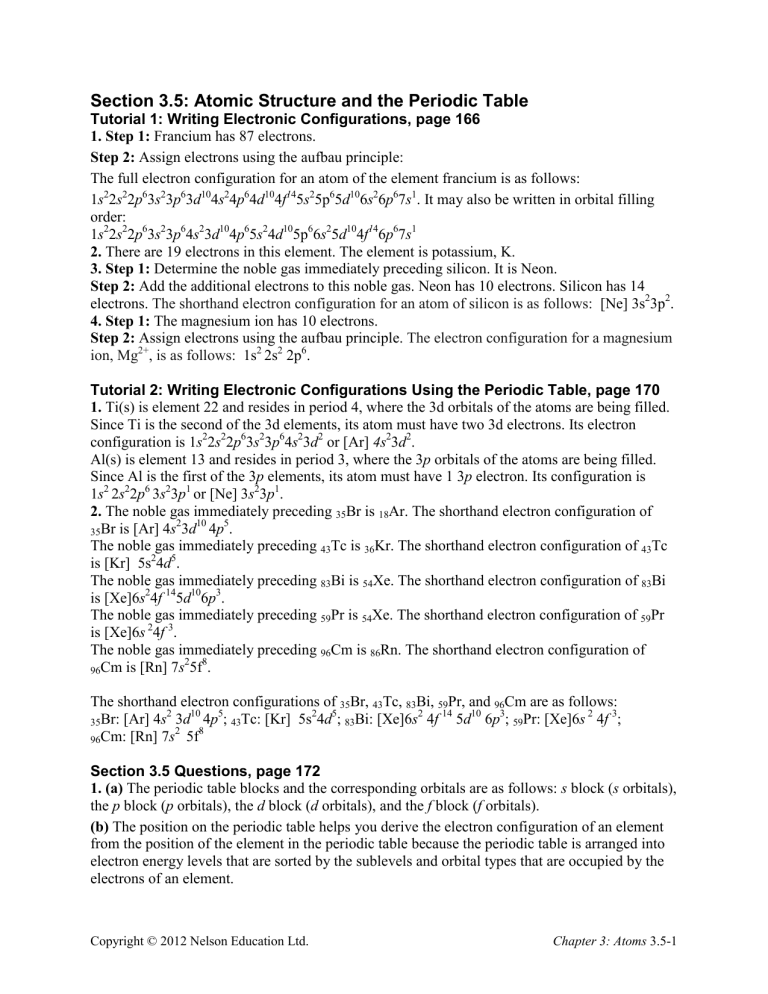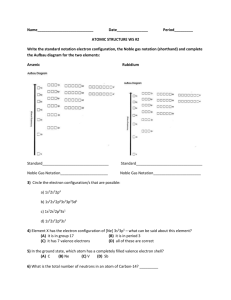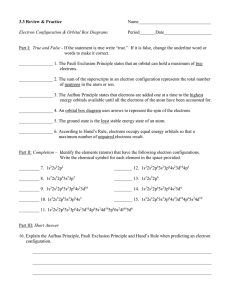Section 3.5: Atomic Structure and the Periodic Table

Section 3.5: Atomic Structure and the Periodic Table
Tutorial 1: Writing Electronic Configurations, page 166
1.
Step 1: Francium has 87 electrons.
Step 2: Assign electrons using the aufbau principle:
The full electron configuration for an atom of the element francium is as follows:
1 s 2 2 s 2 2 p 6 3 s 2 3 p 6 3 d 10 4 s 2 4 p 6 4 d 10 4 f 1 4 5 s 2 5p 6 5 d 10 6 s 2 6 p 6 7 s 1 . It may also be written in orbital filling order:
1 s 2 2 s 2 2 p 6 3 s 2 3 p 6 4 s 2 3 d 10 4 p 6 5 s 2 4 d 10 5p 6 6 s 2 5 d 10 4 f 1 4 6 p 6 7 s 1
2.
There are 19 electrons in this element. The element is potassium, K.
3.
Step 1: Determine the noble gas immediately preceding silicon. It is Neon.
Step 2: Add the additional electrons to this noble gas. Neon has 10 electrons. Silicon has 14 electrons. The shorthand electron configuration for an atom of silicon is as follows: [Ne] 3s 2 3p 2 .
4. Step 1: The magnesium ion has 10 electrons.
Step 2: Assign electrons using the aufbau principle. The electron configuration for a magnesium ion, Mg 2+ , is as follows: 1s 2 2s 2 2p 6 .
Tutorial 2: Writing Electronic Configurations Using the Periodic Table, page 170
1. Ti(s) is element 22 and resides in period 4, where the 3d orbitals of the atoms are being filled.
Since Ti is the second of the 3d elements, its atom must have two 3d electrons. Its electron configuration is 1 s 2 2 s 2 2 p 6 3 s 2 3 p 6 4 s 2 3 d 2 or [Ar] 4s 2 3 d 2 .
Al(s) is element 13 and resides in period 3, where the 3 p orbitals of the atoms are being filled.
Since Al is the first of the 3 p elements, its atom must have 1 3 p electron. Its configuration is
1 s 2 2 s 2 2 p 6 3 s 2 3 p 1 or [Ne] 3
2. The noble gas immediately preceding
35
Br is [Ar] 4 s 2 3 d 10 4 p 5 . s 2 3 p 1 .
35
Br is
18
Ar. The shorthand electron configuration of
The noble gas immediately preceding
43
Tc is
36
Kr. The shorthand electron configuration of
43
Tc is [Kr] 5s 2 4 d 5 .
The noble gas immediately preceding
83 is [Xe]6 s 2 4 f 14 is [Xe]6 s 2 4 f 3 .
5 d 10 6 p 3 .
The noble gas immediately preceding
59
Bi is
54
Xe. The shorthand electron configuration of
83
Bi
Pr is
54
Xe. The shorthand electron configuration of
59
Pr
The noble gas immediately preceding
96
96
Cm is [Rn] 7 s 2 5f 8 .
Cm is
86
Rn. The shorthand electron configuration of
The shorthand electron configurations of
35
35
Br: [Ar] 4 s
96
2 3 d 10 4 p 5 ;
43
Tc: [Kr] 5s 2 4 d
Br,
43
Tc,
83
5 ;
83
Bi: [Xe]6 s
Bi,
2 4 f
59
14
Cm: [Rn] 7 s 2 5f 8
Pr, and
5 d 10 6
96 p 3
Cm are as follows:
;
59
Pr: [Xe]6 s 2 4 f 3 ;
Section 3.5 Questions, page 172
1.
(a) The periodic table blocks and the corresponding orbitals are as follows: s block ( s orbitals), the p block ( p orbitals), the d block ( d orbitals), and the f block ( f orbitals).
(b) The position on the periodic table helps you derive the electron configuration of an element from the position of the element in the periodic table because the periodic table is arranged into electron energy levels that are sorted by the sublevels and orbital types that are occupied by the electrons of an element.
Copyright © 2012 Nelson Education Ltd. Chapter 3: Atoms 3.5-1
(c) The aufbau principle states that electrons occupy lowest energy orbitals first. Hund’s rule states that electrons are not paired within sublevel orbitals until each sublevel orbital has at least one electron.
(d) The order in which orbitals are filled is determined by starting with the lowest energy orbital and continuing to higher energy orbitals. Where there are orbitals of similar energy all the sublevel orbitals must contain at least one electron before a second electron can be added to one of the sublevel orbitals.
2.
3.
(a) Cr: [Ar]4 s 3 d 5 , there are 6 unpaired electrons; Cu: [Ar]4 s 1 3 d 10 , there is 1 unpaired electron
(b) These unpredicted electron configurations occur because the atom is more stable when the higher energy 3 d orbitals are half filled or filled than when the 4 s orbitals are fully filled.
4. Si has 14 electrons. The full electron configuration of Si is 1 s
Ga has 31 electrons. The full electron configuration of Ga is 1 s 2
2 2 s 2
2 s 2
2 p 6
2 p 6 3
3 s 2 3 p 2 . s
As has 33 electrons. The full electron configuration of As is 1 s 2 2 s 2 2 p 6 3 s 2
2 3 p 6 3 d 10 4 s 2 4 p 1 .
3 p 6 4 s 2 3 d 10 4 p 3
Ge has 32 electrons. The full electron configuration of Ge is 1
Al has 13 electrons. The full electron configuration of Al is 1 s s
2
2 2 s
2 s 2
Cd has 48 electrons. The full electron configuration of Cd is 1 s 2 2 s 2
2 2 p
2 p 6
2 p 6
6 3 s
3 s 2
3 s 2
2 3 p 6 4 s 2
3 p 1
3 d 10 4 p 2
.
.
S has 16 electrons. The full electron configuration of S is 1 s 2 2 s 2 2 p
Se has 34 electrons. The full electron configuration of Se is 1 s 2 2 s 2
6 3 s
2 p 6
2
3 s 2
3 p 4
3
3 p p 6
6
.
.
4 s
4 s 2
2 3 d
3 d
10
10
4 p
4 p 4 .
6 5 s 2 4 d 10 .
5.
Cu has 29 electrons. The noble gas immediately preceding it is
18
Ar. The shorthand electron configuration of Cu is [Ar] 4 s
1
3 d
10
.
O has 8 electrons. The noble gas immediately preceding it is
2
He. The shorthand electron configuration of O is [He] 2 s
2
2 p
4
.
La has 57 electrons. The noble gas immediately preceding it is
54
Xe. The shorthand electron configuration of La is [Xe] 6 s
2
4 f
1
.
Y has 39 electrons. The noble gas immediately preceding it is
36
Kr. The shorthand electron configuration of Y is [Kr] 5 s
2
4 d
1
.
Ba has 56 electrons. The noble gas immediately preceding it is
54
Xe. The shorthand electron configuration of Ba is [Xe] 6 s
2
.
Copyright © 2012 Nelson Education Ltd. Chapter 3: Atoms 3.5-2
Tl has 81 electrons. The noble gas immediately preceding it is
54
Xe. The shorthand electron configuration of Tl is [Xe] 6 s
2
4 f
14
5 d
10
6 p
1
.
Bi has 83 electrons. The noble gas immediately preceding it is
54
Xe. The shorthand electron configuration of Bi is [Xe] 6 s
2
4 f
14
5 d
10
6 p
3
.
6. (a) Zn is in period 3, where the 3 d orbitals are being filled. The last electron in Zn enters the
3 d orbital.
(b) I is in period 5, where the 5 p orbitals are being filled. The last electron in I enters the 5 p orbital.
(c) Ba is in period 6, where the 6 s orbitals are being filled. The last electron in Ba enters the 6 s orbital.
7. (a) The third element in Group 15 is in period 4 is arsenic, As. The expected ground-state electron configuration of an atom of in the third element in Group 15 is [Ar]4 s
2
3 d
10
4 p
3
.
(b) Element number 116 is in period 7 is Uuh. The expected ground-state electron configuration of an atom of element number 116 is [Rn] 7 s
2
5 f
14
6 d
10
7 p
4
.
(c) An element with 3 unpaired 5d electrons has a filled 6s orbital, so is in period 6 and follows
Xe in the periodic table. This element is tantalum, Ta. The expected ground-state electron configuration of tantalum is [Xe] 6 s
2
4 f
14
5 d
3
.
(d) The halogen with electrons in the 6p atomic orbitals is astatine, As. The expected groundstate electron configuration of astatine is [Xe] 6 s
2
4 f
14
5 d
10
6 p
5
.
8. (a) The lightest halogen is F, which has 9 electrons. The full electron configuration for F is
1 s
2
2 s
2
2 p
5
.
(b) The answer could be K, Rb, Cs, or Fr. For example, the full electron configuration for an atom of K is 1 s
2
2 s
2
2 p
6
3 s
2
3 p
6
4 s
1
.
(c) The group 13 element in the same period as Sn is In. The full electron configuration for an atom of In is 1 s
2
2 s
2
2 p
6
3 s
2
3 p
6
4 s
2
3 d
10
4 p
6
5 s
2
4 d
10
5 p
1
.
(d) The non-metallic elements in Group 14 are C, Si, and Ge.
An atom of C has 6 electrons. The full electron configuration of C is 1 s
2
2 s
2
2 p
2
.
An atom of Si has 14 electrons. The full electron configuration of Si is 1 s
2
2 s
2
2 p
6
3 s
2
3 p
2
.
An atom of Ge has 32 electrons. The full electron configuration of Ge is
1 s
2
2 s
2
2 p
6
3 s
2
3 p
6
4 s
2
3 d
10
4 p
2
.
9. (a) Boron has 5 electrons.
Copyright © 2012 Nelson Education Ltd. Chapter 3: Atoms 3.5-3
(b ) Silicon has 14 electrons.
(c) Mercury has 80 electrons.
10. (a) Arsenic can have a charge of -3 and +3 because those configurations have no unpaired electrons and have completely filled orbitals, e.g., As
As
(b)
2+
Pb 2+ has a probable configuration of [Xe] 6 s 2 4 f
3+
: [Ar] 4 s is unstable because it valence orbital is partially filled As
3+
2
3 d
10
; As
: [Ar] 4 s
2
3-
: [Ar] 4 s
3 d
10
4 p
1
2
3 d
10
4 p
6
.
14 5 d 10
because the atom is more stable when the entire d block is filled.
Copyright © 2012 Nelson Education Ltd. Chapter 3: Atoms 3.5-4
(c)
Ag has an electron configuration of [Kr] 4 s 1 4 d 10
. Ag
1+
occurs when an electron is lost from the 4 s orbital because the atom is more stable when there are no unpaired electrons.
Copyright © 2012 Nelson Education Ltd. Chapter 3: Atoms 3.5-5





